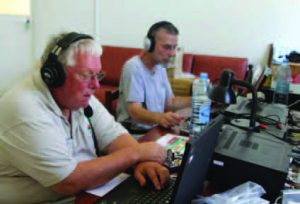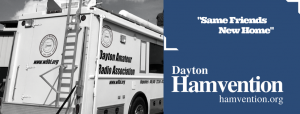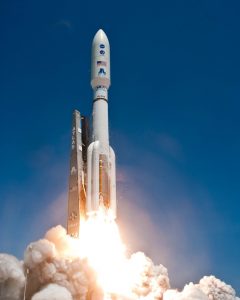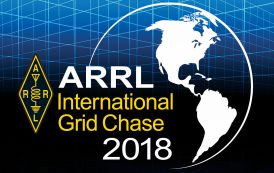By James Careless
Many people who work in broadcast radio got their start as amateur radio operators — hams — and remain active in the hobby.
At iHeartMedia alone, “we have 157 people on our ham radio list,” said Charles Wooten, director of engineering and IT at iHeartMedia Panama City, Fla. An amateur radio operator himself since the age of 12 (call sign NF4A), Wooten maintains that list. “Ninety percent of them are engineers, but we also have DJs, program directors and operations directors.” At least four of the company’s regional engineering VPs are hams.
The fact that so many of iHeart’s hams are engineers makes sense. Many of the skills that a ham learns to get on air are the same needed by a technical broadcast professional. “Ohm’s Law is Ohm’s Law, whether you are using it to work on a home-built amateur radio transmitter or to keep a major-market radio station on air,” said Walter Palmer, W4ALT and director of broadcast operations, engineering and programming at Newsradio WGMD 92.7 FM in Rehoboth Beach, Del. “So it makes sense that someone who loved ham as a teenager would be drawn to radio engineering as a career. It was certainly true for me.”
ONE LOVE DROVE ANOTHER
There’s a good reason so many professional radio engineers started as ham radio operators: They were exposed to the hobby long before needing to find a job. This was the case for Wooten.
“When I was 11, I was curious as to what was causing the TV interference to my Saturday morning cartoons,” he recalled. “Once I figured out that it was a neighbor’s ham radio rig and got to see his shack for myself, I caught the bug right there and studied to get my ham license.”
In turn, the RF propagation and electrical knowledge Wooten gained as a teenaged ham — often building his own equipment for very little money — gave him the insight and interest to seek out radio engineering as a career.
The same is true for Brad Humphries, AE4VJ and market director of engineering for the Beasley Media Group in Charlotte, N.C.
“I’ve been an electronic nerd most of my life, and a ham since I was 14,” said Humphries. “A summer job at a local amusement park led me into fixing up their handheld radio system using my ham knowledge, which eventually led me into broadcasting.”
Steve Dove, W3EEE and minister of algorithms for Wheatstone, said via email, “I got my license, G3YDV, as soon as it was legally possible at 14; for a brief while, I think I was the youngest ham in the [UK].” His entry into broadcasting? “I was a young, restless and somewhat rebellious anti-establishment teenager. The ’60s ship-borne pirate radio station era (Radio London, Radio Caroline) was drawing to a close, and hordes of little land-based pirates filled the gap; including me.”
As part of that merry band, Dove and his fellow pirates built home-brew tube transmitters up to 100 watts, and then the consoles to produce programming.
“In order to pay the subsequent fine when we were caught, we started a mobile disco using the studio gear and an equally home-brew PA, and the console drew the attention of a ‘proper’ console manufacturer, Alice,” Dove said. “Commercial broadcasting started late in the UK [early ’70s] and the timing was perfect; of the first 40 stations, we had consoles in 19 of them.” He subsequently did console work while touring with AC/DC, Jethro Tull and Yes in his pre-Wheatstone days.
On the flip side, Nautel Regional Sales Manager Asia/Pacific Chuck Kelly, VE1MDO, got into amateur radio while working as a radio engineer.
“My father and grandfather were hams, so you could say that I grew up with the hobby,” Kelly said. “But it wasn’t until I was working in radio that I saw how having an amateur radio license and equipment could help my job; especially during emergencies where regular communications were down.”
In the 1970s, Scott Westerman, W9WSW, was working in broadcast radio at Michigan State University, where he is now associate vice president for alumni relations. That was when he learned how useful ham radio operators could be during emergencies, providing lifeline communications for first responders and the public alike.
“Today, I am a licensed ham who belongs to the SKYWARN tornado spotter’s network,” Westerman said. “We keep an eye out for signs of pre-tornado swirling clouds from various locations, and radio that information into the National Weather Service during severe weather.”
MACGYVERISH GIFT TO RADIO ENGINEERS
There is no doubt that ham radio has inspired many of its youngest practitioners with a love of radio transmission and technology, a love that guided them to professional careers in radio broadcasting. The industry is better off for it.
But amateur radio has done more for radio than provide it with a pool of talented, motivated employees. It has also given these people an intellectual grounding in the basics of radio engineering, combined with a MacGyverish ability to make things work; no matter what.

Wooten’s engineering vehicle in Biloxi, Miss., the day after Hurricane Katrina hit the Gulf
Photo courtesy Charles Wooten
“I don’t think that there is anyone who understands radio science and technology at such as profound a level as hams,” said Chuck Kelly. “They’ve got such a deep grasp of radio that they can dive into and fix equipment problems at the most basic level; down to individual resistors, capacitors and diodes.”
This profound knowledge and know-how is a function of equipment-buying poverty; particularly among older hams when they were teenagers.
“When I was starting out as a kid in amateur radio, I didn’t have a lot of money, so I learned to make do with what I had at hand,” said Wooten. “This teaches you creative engineering and trouble-shooting skills that really pay off at a radio station when things go wrong; especially during an emergency when spare parts aren’t readily available.”
A case in point: During Hurricane Katrina in 2005, Wooten used his ham radio skills to keep the Clear Channel cluster of five radio stations in Biloxi, Miss., on the air.
“Without the ability to improvise and work with what we had, we would have gone dark when people most needed us,” he said. Using his ham skills, Wooten and his team nursed a generator with a water leak along for a few days, keeping the five stations on air until a new one could be brought it. They also used a portable satellite dish to create a two-way satellite link.
“We were the only stations in the Biloxi area with telephone service,” Wooten recalled. “The satellite channel provided T-1 [1.544 Mpbs] bandwidth, part of which was used for a couple of Cisco IP phones connected back to the corporate offices in Texas. The staff could call anywhere on these phones.”
All told, it was a fix MacGyver would have been proud of.
“Ham radio is all about using what you’ve got laying around, when you have to do something,” said Brad Humphries. “That is a good skill to have, because in the middle of the night when you have a problem at the radio station, you’re just going to have what you’ve got at hand to do something with.”
A SOURCE OF NEW BLOOD FOR RADIO?

iHeartMedia’s Charles Wooten, NF4A, left, and Tad Williamson Jr., WF4W, are shown at C82DX, a 2013 amateur radio event in Xai Xai, Mozambique.
Photo courtesy Charles Wooten
It is widely held in the radio industry that engineering talent is scarce and becoming scarcer as engineers retire. At the same time, the upcoming generation of technically-minded youth is attracted to information technology rather than RF transmission and radio broadcasting. This begs a question: Could young people who are signing up as hams serve as an engineering talent pool for the radio broadcasting industry?
After all, “A repeater used for AM broadcasting is identical to one used by amateur radio operators,” said Dana Puopolo, a licensed ham (K1PUW) for 43 years and chief engineer of WGLS(FM)/Rowan University Radio in Glassboro, N.J.
“My ham walkie-talkie was type-accepted to work both for amateur and commercial radio usage, while the antennas used by AM radio and the 160 meter ham band are basically identical, except for their configurations. So yes, there is enough crossover between ham radio and commercial radio to justify training hams as professional engineers.”
This said, attracting young hams to radio broadcasting would require some changes in the radio industry.
“iHeartMedia pays our engineers well and treats them fairly, but there are many stations that don’t,” said Wooten. “Without better working conditions, talented young hams are likely to go into other fields of engineering; even though they love radio and we could use them here.”
Whatever happens, one thing is clear: The strong bonds between amateur radio and commercial radio continue to benefit the broadcasting industry, and inspire a love of the medium not found in many technical industries.
Source: Radio World News










